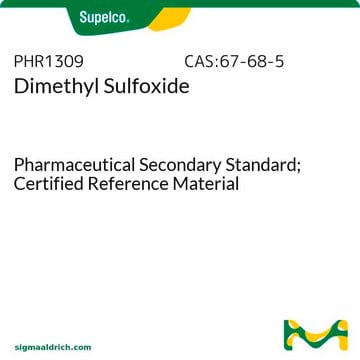1211006
USP
Diméthylsulfoxyde
United States Pharmacopeia (USP) Reference Standard
Synonyme(s) :
DMSO, Sulfoxyde de méthyle
About This Item
Produits recommandés
Qualité
pharmaceutical primary standard
Densité de vapeur
2.7 (vs air)
Pression de vapeur
0.42 mmHg ( 20 °C)
Température d'inflammation spontanée
573 °F
Limite d'explosivité
42 %, 63 °F
Fabricant/nom de marque
USP
Disponibilité
not available in (Sales restrictions may apply)
Indice de réfraction
n20/D 1.479 (lit.)
Point d'ébullition
189 °C (lit.)
Pf
16-19 °C (lit.)
Densité
1.10 g/mL (lit.)
Application(s)
pharmaceutical (small molecule)
Format
neat
Chaîne SMILES
CS(C)=O
InChI
1S/C2H6OS/c1-4(2)3/h1-2H3
Clé InChI
IAZDPXIOMUYVGZ-UHFFFAOYSA-N
Vous recherchez des produits similaires ? Visite Guide de comparaison des produits
Description générale
Application
- Dimethyl Sulfoxide Irrigation
- Dimethyl Sulfoxide Gel
- Dimethyl Sulfoxide Topical Solution
- Methylsulfonylmethane
Attention
Remarque sur l'analyse
Autres remarques
Produit(s) apparenté(s)
Code de la classe de stockage
11 - Combustible Solids
Classe de danger pour l'eau (WGK)
WGK 1
Point d'éclair (°F)
Not applicable
Point d'éclair (°C)
Not applicable
Certificats d'analyse (COA)
Recherchez un Certificats d'analyse (COA) en saisissant le numéro de lot du produit. Les numéros de lot figurent sur l'étiquette du produit après les mots "Lot" ou "Batch".
Déjà en possession de ce produit ?
Retrouvez la documentation relative aux produits que vous avez récemment achetés dans la Bibliothèque de documents.
Les clients ont également consulté
Notre équipe de scientifiques dispose d'une expérience dans tous les secteurs de la recherche, notamment en sciences de la vie, science des matériaux, synthèse chimique, chromatographie, analyse et dans de nombreux autres domaines..
Contacter notre Service technique


